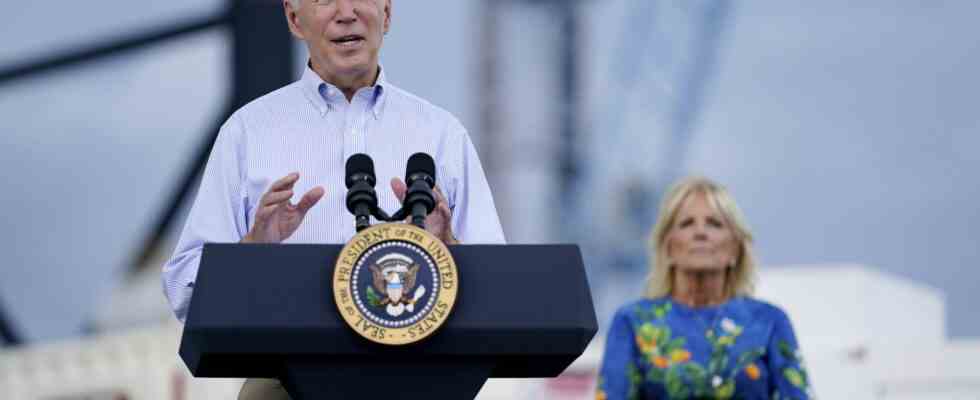Status: 04.10.2022 08:45 a.m
While the extent of Hurricane “Ian” is only becoming clear in Florida, US President Biden is promising aid for Puerto Rico, where Hurricane “Fiona” has caused great damage. Experts see the severity of storms as a result of climate change.
After major damage caused by Hurricane Fiona in mid-September, US President Joe Biden promised support to the people of Puerto Rico during a visit to the island. Among other things, Biden promised more than $60 million in new financial aid to better prepare Puerto Rico for future hurricanes. Biden wrote on Twitter that the people of Puerto Rico deserve every bit of help.
Biden: People have had to go through so much
During his visit to the US foreign territory, Biden explained that the people on the Caribbean island had to go through so much in recent years and did not always get help in time. The US President is alluding to Hurricane Maria in 2017 and the disaster management of his predecessor Donald Trump. Hurricane Maria killed nearly 3,000 people. At the time, Trump refused to acknowledge the high number of hurricane deaths. Puerto Rico’s infrastructure was still suffering from the consequences.
Hurricane Fiona destroyed infrastructure again
“Fiona” has now made the ailing situation on the island worse again: floods and landslides destroyed some of the rebuilt infrastructure and houses again. According to utility Luma Energy yesterday, seven percent of customers — about 100,000 connections — were still without power a good two weeks after the storm.
In a statement, Puerto Rico’s governor Pedro Pierluisi emphasized the good cooperation with Biden’s government. “We want to be treated the same way as our fellow citizens in the States in times of need,” it said.
Also in Florida damage from hurricane
Biden also wants to visit the US state of Florida tomorrow, where hurricane “Ian” had caused enormous damage in the past few days. Only days after the hurricane hit the coast did the extent of the destruction become clear. In addition to completely flattened residential areas, destroyed bridges and power lines, the death toll rose to at least 62-58 in Florida and four in North Carolina, according to authorities. The US Coast Guard, meanwhile, said it is halting the search for 16 migrants believed to be missing after their boat capsized during the hurricane.
The hurricane is considered one of the most violent storms to ever hit the United States mainland. It first moved across the Atlantic from the west coast of Florida before the hurricane reached the US state of South Carolina on Friday afternoon with wind speeds of 140 kilometers per hour.
USA and Cuba in exchange?
Damage from hurricane “Ian” was not only seen in the United States – the storm also made landfall in Cuba. In the meantime, the whole country was without electricity. Now the governments of the USA and Cuba are said to be in an exchange about the damage that “Ian” caused in both countries. This is reported by the pro-government Cuban news agency “Prensa Latina”, citing a corresponding statement from the Cuban Ministry of Foreign Affairs. The Wall Street Journal previously reported on Cuba’s unusual request for help from the United States.
The relationship between the USA and Cuba has traditionally been very tense due to ideological differences. Cuba blames a decade-long US embargo for the supply crisis on the Caribbean island. The United States recently pointed out that the embargo does not prohibit humanitarian aid to Cuba.
climate change as a cause
After several hurricanes have caused severe damage within a short period of time, many are asking: Coincidence or the result of climate change? Karthik Balaguru, climate scientist at Pacific Northwest National Laboratory has been analyzing hurricane data for years. He sees a clear concatenation: “If you look at climate change, you cannot clearly state that there are more hurricanes today than in the past.” However, it is also clear that with climate change the storms will become stronger and produce significantly more rainfall.
Storms increase in strength quickly
In fact, since 2017, more category four or higher storms have struck US coasts than in previous years: Hurricanes “Harvey”, “Irma”, “Maria”, “Michael”, “Laura”, “Ida” and now ” Ian” and “Fiona” all had the same pattern: They were gaining strength at breakneck speed. Balaguru explained that this rapid intensification is defined by “a storm increases in wind speed by at least 30 knots or 35 miles per hour within 24 hours”. That affects the predictions. In this case, “Ian” gained massive strength just off the coast, says Balaguru. “There was little time left for preparations.”
Warming of the oceans fatal
The climate scientist explains that the warming of the oceans is responsible for the hurricane suddenly picking up speed. Coming from the Caribbean and Cuba, Hurricane “Ian” crossed large areas of relatively warm water – in some cases the water surface was around 32 degrees Celsius. According to the climate scientist, this is “much warmer at this time of year”. “Ian” absorbed large amounts of moisture.
Storms become extremely charged. They get stronger by absorbing heat from the sea. If then, as in this case, there is a very low vertical wind force in the atmosphere, this leads to rapid intensification.
“Ian” had ten percent more rain in his luggage than previous comparable storms. For the scientist, this means: With the increase in global warming, there will not necessarily be more hurricanes on the east coast of the USA in the future, but their destructive power through wind, rain and flooding will increase.
With information from Claudia Sarre, ARD Studio Washington

